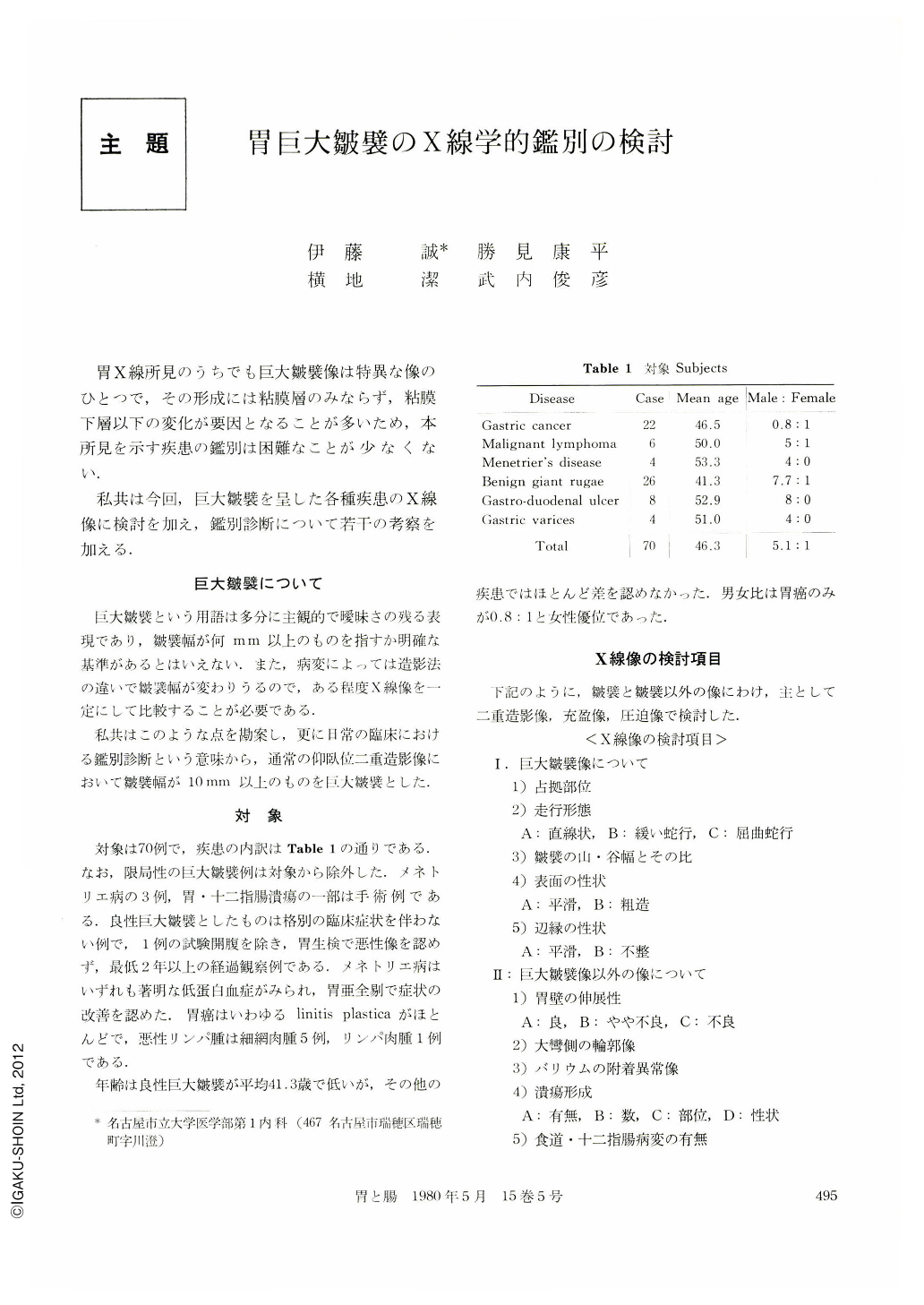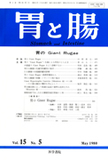Japanese
English
- 有料閲覧
- Abstract 文献概要
- 1ページ目 Look Inside
胃X線所見のうちでも巨大皺襞像は特異な像のひとつで,その形成には粘膜層のみならず,粘膜下層以下の変化が要因となることが多いため,本所見を示す疾患の鑑別は困難なことが少なくない.
私共は今回,巨大皺襞を呈した各種疾患のX線像に検討を加え,鑑別診断について若干の考察を加える.
On seventy cases of gastric giant rugae, roentgenologic features are investigated and differential diagnosis is discussed.
Subjects included twenty-six cases of benign giant rugae, four cases of Menetrier's disease, twenty-two cases of gastric carcinomas, six cases of malignant lymphoma, eight cases of gastroduodenal ulcers and four cases of gastric varices.
Several differential points of each disease are discussed about the nature of giant rugae itself, i.e. 1) location, 2) patterns of form, 3) the width of giant rugae and that of rugal interval and their ratio (concavoconvex ratio), 4) irregularity of rugal surface and edge and also discussed are the accessory findings to giant rugae, i.e. 1) pliability of the gastric wall, 2) configuration of the greater curvature, 3) barium mixture sign, 4) shape and number of ulceration, 5) Coexistence of esophageal and duodenal lesion.
We defined the gastric giant rugae to be more than lcm in width in ordinary double contrast ray films on supine position.
The roentgenologic features of each disease are as follows:
In gastric carcinoma, the most popular patterns of giant rugae are of straight form and irregular shape in the surface and the edge. The rugal concavoconvex ratio is high, which becomes greater with the narrowing of gastric lumen. The pliability of gastric wall is disturbed more or less and single irregular Hc-like ulcer formation is observed in 73% of this disease. In malignant lymphoma, the rugae are usually straight formed and the rugal surface and edge are sometimes irregullar but smoother than that of gastric carcinoma. Although the concavoconvex ratio is high, the pliability is usually kept, which should be distinguished from gastric carcinoma. Ulcer formation is always complicated and ulcers are irregular, particulary multiple. The complication of duodenal lesion is observed in 50% of this disease. In Menetrier's disease, the rugae are usually sigmoid formed but sometimes winding. The mucosal surface of giant rugae is more uneven than any other diseases but the pliability of gastric wall is good and the concavoconvex ratio is usually low. Microscopically, extreme hyperplasia of mucosal layer is recognized and this hyperplasia is thought to produce the irregularity of rugal surface and edge. And this finding is also seen in 30% of gastric carcinoma cases. The abnormal configuration of the greater curvature and barium mixture sign are frequently seen. In benign giant rugae, sigmoid formed rugae with smooth surface and edge are most frequently seen and the concavoconvex ratio is low. The picture of abnormal configuration of the greater curvature and barium mixture sign are common, which means the pliability of gastric wall and the capacity of rugal interval. Of course neither ulceration nor rigidity of gastric wall is found. In gastroduodenal ulcers, the location and rugal form resemble benign giant rugae but sometimes the giant rugae diminish with the healing course of peptic ulcers. There exist large, deep and usually penetrated benign-looking ulcer formation. In gastric varices, the sigmoid formed rugae with smooth surface and edge are usual. The pliability of gastric wall is good and the concavoconvex ratio is high. The rugae are always located in the upper body region, especially the fornix and sometimes are complicated with esophageal varices.

Copyright © 1980, Igaku-Shoin Ltd. All rights reserved.


